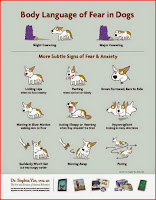Originally posted in 2015
We can help keep our dogs and children safe by learning about dog body language. Understanding what dogs are communicating to us allows us to advocate for our dogs, to mediate dog-child interactions, and to teach our children how to be safe and respectful around dogs.We have a 2 1/2 year old son who is very active and loves dogs.
2021 Update: Our son is now 8 1/2 and absolutely in love with all animals.
We encourage him to interact with our dogs and show his love for them by:
- Helping us with feeding times (supervision means our hands are closer to the dog than his)
- Playing "fetch" and/or throwing toys for the dog (parent is there to help cue "drop it" and to ensure toddler does not take toy from dog's mouth)
- Pet gently on the back or chest (again, parent's hands are on the dog as well and ensuring touch is gentle)
- Asking her to "sit" and giving her a treat (with an open hand to avoid accidental nips)
We have the following expectations in how our child interacts with our dogs:
- Hands are always gentle, no pulling on ears or tail, no grabbing, no hitting, no sitting or climbing on the dog, no hugging or kissing *this is very important. Most dogs do not enjoy hugs or kisses and we do not want children's faces close enough to the dog to risk a bite
- If a dog is sleeping or laying on a bed or in a kennel, they are not to be disturbed
- If a dog has a bone she is behind a baby gate or in her kennel and cannot be reached by any children
- Once a dog has been released to eat her dinner, nobody touches the food or dishes (or Kong wobbler), the dog is left to eat in peace
Toddlers are toddlers, so they will not always adhere to these rules, and it is important that parents are actively supervising all interactions, being aware of our dog's body language and signals. Toddlers are also silly and have lots of energy. When our little guy is running around squealing, screaming, jumping up and down, and generally acting like a toddler does... We provide a safe, quiet place for our dogs to get away, and/or we take one or both of them outside to burn off the energy :) We really enjoy going for walks with both our son and dogs and it is a fun, safe way for them to bond.
*Supervision cannot be effective unless we know what to look for.
Here are some excellent resources:Doggone Safe: http://www.doggonesafe.com
Family Paws: http://familypaws.com
Dr. Sophia Yin:
Turid Rugaas: http://en.turid-rugaas.no/calming-signals-photos.html
And for our local readers, the Winnipeg Humane Society has some excellent classes on safety with babies and dogs: http://www.winnipeghumanesociety.ca/pet-owners/classes-and-education/classes/dogs-storks/
As well as a workshop on dog body language: http://www.winnipeghumanesociety.ca/pet-owners/classes-and-education/classes/what-is-my-dog-saying/
In addition to the information above, Dr. Sophia Yin also has a dog body language poster available for download: http://info.drsophiayin.com/free-poster-on-body-language-in-dogs/
Author's note: This article was originally written for Bite Prevention Week 2015. I attempted to ensure all links are valid, please contact me should you have any questions or find any broken links.
2016 update: The Winnipeg Humane Society has a Dogs & Toddlers course coming up on Thursday, May 26th from 7-9pm. Visit their site for information on this and other great workshops and classes available: http://www.winnipeghumanesociety.ca/pet-owners/classes-and-education/classes/workshops-2/
 |
| http://www.winnipeghumanesociety.ca/pet-owners/classes-and-education/classes/workshops-2/dogs-toddlers/ |










No comments:
Post a Comment